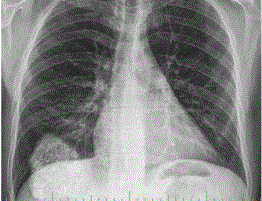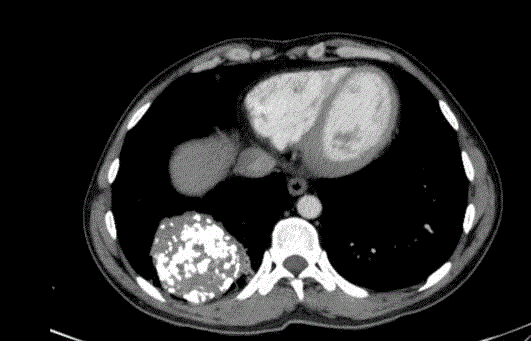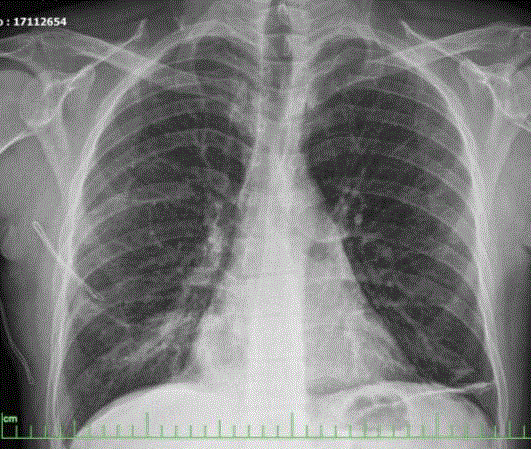Clinical Image
A Large Pulmonary Hamartoma
Şahin F*, Koç Ç and Aslan AF
Department of Chest Disease, University of Health Sciences/Yedikule Chest Disease and Thoracic Surgery Health
Practice and Research Center, Turkey
*Corresponding author: Füsun Şahin, Department of Chest Disease, University of Health Sciences/ Yedikule Chest Disease and Thoracic Surgery Health Practice and Research Center, Istanbul, Turkey
Published: 24 Jan, 2018
Cite this article as: Şahin F, Koç Ç, Aslan AF. A Large
Pulmonary Hamartoma. Clin Surg.
2018; 3: 1889.
Clinical Image
Pulmonary hamartomas are composed of varying amounts of cartilage, fatty, smooth muscle and fibrous tissue as they originate from mesenchymal cells [1]. The incidence of pulmonary hamartoma is 0.25% with a two to four fold male predominance. Most are found in the 6th decade. Clinical presentation is usually asymptomatic solitary nodule on the routine chest X-ray [2]. Pulmonary hamartomas usually present as solitary pulmonary nodules and less than 5 cm in diameter. Giant pulmonary hamartomas reported in the English literature measure between 9 cm to 30 cm [3]. Most parenchymal lesions are not associated with bronchial tree, primary endobronchial lesions are rare (8% to 10%) and polypoid masses originating from large bronchi [4]. Definite diagnosis and the treatment can be achieved by surgical resection with minimal morbidity. Our case is a 26-year-old man was admitted to our hospital hemoptysis for five days. Chest X-ray and Thorax Computed Tomography (CT) showed a giant heterogen solid intrapulmonary mass with dense punctate microcalcifications in the lower lobe of the right lung (Figure 1 and 2). Although there was no endobronchial lesion on the bronchoscopy, hemoptysis was present. The tumour was resected by enucleation. Macroscopic appearence of the tumour was 10 cm x 9 cm x 8 cm. Yellowish-white color and bone hardness solid mass. The environment parenchyma is bleached spongy. The pathologic diagnosis was chondroid hamartoma. After a period of 2 months follow-up, our patient is healthy (Figure 3). Our case has typical histological and radiological features of chondroid hamartoma but the size of the tumour and hemoptysis (although not endobronchial type) makes it an unusual case.
Figure 1
Figure 2
Figure 3
References
- Okudela K, Umeda S, Otara M, Honda E, Ohmori T, Tejari M, et al. A case of pulmonary hamartoma with distinctive histopathologi-cal features: a discussion of its differential diagnosis and histo-genesis. Pathol Int. 2014;64(12):618-23.
- Gjevre J, Myers J, Prakash U. Pulmonary hamartomas. Mayo Clin Proc. 1996;71(1):14-20.
- Hutter J, Reich-Weinberger S, Hutarew G, Stein HJ. Giant pulmonary hamartoma-a rare presentation of a common tumor. Ann Thorac Surg. 2006;82:e5-7.
- Hansen CP, Holtveg H, Francis D. Pulmonary hamartoma. J Thorac Cardiovasc Surg. 2009;57:166-8.



